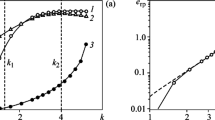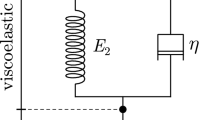Abstract
A coupled fracture model is proposed and implemented to investigate the deformation and fracture of elastoplastic materials. The fracture model parameters are determined by constructing true stress–strain curves and determining the limiting characteristics of 12Kh18N10T and 10KhSND steel. Numerical simulation results for the fracture of cylindrical rods under tension are presented. It is revealed that the type and nature of tensile fracture of cylindrical samples determined in calculations are in good agreement with experimental data.




Similar content being viewed by others
REFERENCES
P. S. Volegov, D. S. Gribov, and P. V. Trusov, “Damage and Fracture: Review of Experimental Studies," Fiz. Mezomekh. 19 (3), 68–86 (2016) [Phys. Mesomech. 19 (3), 319–331 (2016)].
I. A. Volkov and Yu. G. Korotkikh, Equations of State for Damaged Viscoelastic-Plastic Media (Fizmatlit, Moscow, 2008) [in Russian].
A. I. Sadyrin, “Simulation of Dynamic Deformation and Fracture of Structural Elastoplastic Materials," Probl. Prochn. Plast. 74, 28–39 (2012).
Strength of Materials and Structural Elements in Extreme Conditions, Ed. by G. S. Pisarenko (Naukova Dumka, Kiev, 1980), Vol. 1 [in Russian].
Strength of Materials and Structural Elements in Extreme Conditions, Ed. by G. S. Pisarenko (Naukova Dumka, Kiev, 1980), Vol. 2 [in Russian].
A. A. Lebedev, “Development of the Theories of Strength in the Mechanics of Materials," Probl. Proch., No. 5, 127–146 (2010) [Strength Mater. 42, 578–592 (2010)].
I. I. Goldenblat and V. A. Kopnov, Strength and Plasticity Criteria of Structural Materials (Mashinostroenie, Moscow, 1968) [in Russian].
B. L. Glushak, S. A. Novikov, A. I. Ruzanov, and A. I. Sadyrin, Fracture of Deformable Media under Pulse Loads (Lobachevsky State Univ. of Nizhny Novgorod, Nizhny Novgorod, 1992) [in Russian].
D. A. Kazakov, S. A. Kapustin, and Yu. G. Korotkikh, Simulation of Deformation and Fracture of Materials and Structures (Lobachevsky State Univ. of Nizhny Novgorod, Nizhny Novgorod, 1999) [in Russian].
A. A. Lebedev, B. I. Kovalchuk, F. F. Giginyak, and V. P. Lamashevskii, Mechanical Properties of Structural Materials under Complex Stress State: Handbook (Izd. Dom “In Yure," Kiev, 2003) [in Russian].
Ya. B. Fridman, Mechanical Properties of Metals (Oborongiz, Moscow, 1952) [in Russian].
J. Lemaitre, Damage Mechanics (The Bath Press, Paris, 1990).
V. N. Kukudzhanov, “Coupled Models of Elastoplasticity and Damage and Their Integration," Izv. Ross. Akad. Nauk, Mekh. Tv. Tela, No. 6, 103–135 (2006) [Mech. Solids 41 (6), 83–109 (2006)].
N. G. Chausov, E. E. Zasimchuk, L. I. Markashova, et al., “Deformation of Plastic Materials under Dynamic Non-Equilibrium Processes," Zavod. Lab. Diag. Mater. 75 (6), 52–59 (2009).
G. Lemaitre, “Continuum Damage Theory Used to Calculate the Failure of Ductile Materials," Teoret. Osn. Inzh. Rasch. 108 (1), 91–98 (1985).
A. A. Lebedev, N. G. Chausov, and A. Z. Bogdanovich, “Assessment of Limiting Damage in Materials under Static Loading with the Account of a Stress State," Probl. Prochn., No. 2, 35–40 (2002) [Strength of Mater. 34, 131–134 (2002)].
V. G. Bazhenov, S. V. Zefirov, L. N. Kramarev, et al., “Method for Determining the Deformation and Strength Properties of Materials in the Case of Large Strains and Inhomogeneous Stress–Strain State," RF Patent No. 2324162 MPK G 01 N 3/00 (2006.01), Publ. May 10, 2008, Byul. No. 13.
V. G. Bazhenov, S. V. Zefirov, and S. L. Osetrov, “Experimental and Computing Method for Constructing True Deformation Diagrams at Large Strains on the Basis of Tests for Hardness," Dokl. Akad. Nauk 407 (2), 183–185 (2006) [Dokl. Phys. 51, 118–121 (2006)].
V. G. Bazhenov, S. V. Zefirov, and S. L. Osetrov, “Experimental and Computational Method for Identifying the Deformation and Strength Properties of Materials," Zavod. Lab. Diag. Mater. 72 (9), 39–45 (2006).
V. G. Bazhenov, S. V. Zefirov, and S. L. Osetrov, “Method for Identifying the Deformation and Strength Properties of Metals and Alloys," Deform. Razr. Mater., No. 3, 43–48 (2007).
V. G. Bazhenov, V. K. Lomunov, S. L. Osetrov, and E. V. Pavlenkova, “Experimental and Computational Method of Studying Large Elastoplastic Deformations of Cylindrical Shells in Tension to Rupture and Constructing Strain Diagrams for an Inhomogeneous Stress–Strain State," Prikl. Mekh. Tekh. Fiz. 54 (1), 116–124 (2013) [J. Appl. Mech. Tech. Phys. 54 (1), 100–107 (2013)].
Author information
Authors and Affiliations
Corresponding author
Additional information
Translated from Prikladnaya Mekhanika i Tekhnicheskaya Fizika, 2021, Vol. 63, No. 1, pp. 122-129. https://doi.org/10.15372/PMTF20220116.
Rights and permissions
About this article
Cite this article
Bazhenov, V.G., Osetrov, S.L., Osetrov, D.L. et al. COUPLED FRACTURE MODEL OF ELASTOPLASTIC MATERIALS BASED ON A KINETIC EQUATION OF DAMAGE ACCUMULATION AND THE PISARENKO–LEBEDEV STRENGTH CRITERION. J Appl Mech Tech Phy 63, 104–110 (2022). https://doi.org/10.1134/S0021894422010163
Received:
Revised:
Accepted:
Published:
Issue Date:
DOI: https://doi.org/10.1134/S0021894422010163




